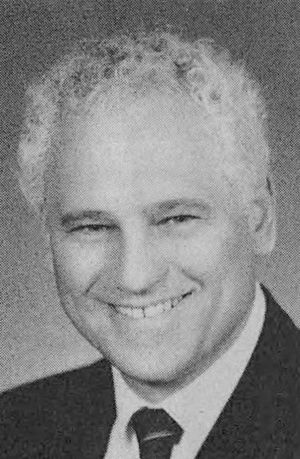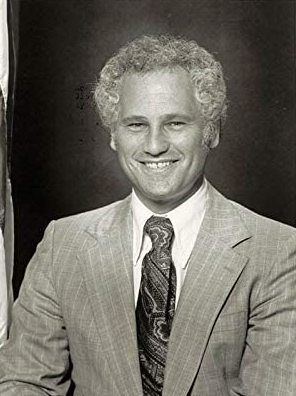Neil Goldschmidt facts for kids
Quick facts for kids
Neil Goldschmidt
|
|
|---|---|

Goldschmidt in 1986
|
|
| 33rd Governor of Oregon | |
| In office January 12, 1987 – January 14, 1991 |
|
| Preceded by | Victor Atiyeh |
| Succeeded by | Barbara Roberts |
| 6th United States Secretary of Transportation | |
| In office September 24, 1979 – January 20, 1981 |
|
| President | Jimmy Carter |
| Preceded by | Brock Adams |
| Succeeded by | Drew Lewis |
| 45th Mayor of Portland | |
| In office January 2, 1973 – August 15, 1979 |
|
| Preceded by | Terry Schrunk |
| Succeeded by | Connie McCready |
| Personal details | |
| Born | June 16, 1940 Eugene, Oregon, U.S. |
| Died | June 12, 2024 (aged 83) Portland, Oregon, U.S. |
| Political party | Democratic |
| Spouses |
Margaret Wood
(m. 1965; div. 1990)Diana Snowden
(m. 1994) |
| Children | 4 |
| Education | University of Oregon (BA) University of California, Berkeley (JD) |
Neil Edward Goldschmidt (born June 16, 1940 – died June 12, 2024) was an important American politician from Oregon. He was a member of the Democratic Party. Goldschmidt held many important jobs over three decades.
He served as the United States Secretary of Transportation for President Jimmy Carter. He was also the governor of Oregon. At one point, many people thought he was the most powerful person in Oregon politics.
Goldschmidt was elected to the Portland City Council in 1970. Then, in 1972, he became the Mayor of Portland. He was the youngest mayor of a major American city at that time. He helped make Downtown Portland a better place. He also helped shape how people traveled around Portland. He stopped the building of a big highway called the Mount Hood Freeway. Instead, he helped create the MAX Light Rail system.
In 1979, President Jimmy Carter chose him to be the U.S. Secretary of Transportation. In this role, he worked to help the car industry. He also helped make rules simpler for airlines, trucking, and railroads. He stayed in this job until 1981. After that, he worked for the company Nike for several years.
In 1986, Goldschmidt was elected the 33rd governor of Oregon. He served one term. During his time as governor, he faced challenges like a movement against taxes. He worked with different political groups to reduce rules and fix the state's roads and bridges. He also made changes to the State Accident Insurance Fund (SAIF), which helps workers who get hurt on the job.
Even though he was popular, Goldschmidt did not run for governor again. After leaving office, he became a lobbyist. This meant he worked to influence government decisions for different companies. He faced some criticism for his business activities. For example, he supported a company called Weyerhaeuser in taking over another Oregon company. He also supported a firm trying to take over Portland General Electric. In 2003, Governor Ted Kulongoski appointed him to the Oregon Board of Higher Education, but he later resigned from this position.
Contents
Early Life and Education
Neil Goldschmidt was born in Eugene, Oregon, on June 16, 1940. His family was Jewish. He went to South Eugene High School. After high school, he studied at the University of Oregon in Eugene. He was even the student body president there. He earned a degree in political science in 1963.
He then went to the University of California, Berkeley and earned a law degree in 1967. From 1967 to 1970, he worked as a legal aid lawyer in Portland, Oregon. This meant he helped people who couldn't afford a lawyer. In 1964, he worked for U.S. Senator Maurine Brown Neuberger. He also helped register voters in Mississippi during the Freedom Summer civil rights campaign in 1964.
Political Career
Serving Portland: City Commissioner and Mayor
Goldschmidt won a seat on the Portland City Council in 1970. He served as a City Commissioner from 1971 to 1973. Then, he became the Mayor of Portland, serving from 1973 to 1979. He played a big part in making downtown Portland a lively place again.
He led a movement against building the Mount Hood Freeway. This highway would have cut through southeast Portland. Instead, he helped get federal money for other projects. These projects included the MAX Light Rail line and the Portland Transit Mall. He also helped make the city government more open to people from different neighborhoods and minority groups. He appointed women and African-Americans to important roles. During his mayoral campaign, he focused on preventing crime rather than just expanding the police force. Many people believed he was Oregon's most successful and inspiring leader for a long time.
In 1973, Governor Tom McCall asked Goldschmidt to join a special group. This group looked for ways to improve transportation in the region. They decided against building the Mount Hood Freeway. Instead, the money was used for other road projects and the first part of the MAX light rail system. This light rail line was finished in 1986.
Leading Transportation for the U.S.
In 1979, Neil Goldschmidt became the sixth U.S. Secretary of Transportation. President Jimmy Carter chose him for this job. He was officially sworn in on September 24. In this role, Goldschmidt was known for helping the car industry, which was struggling financially. He also worked to make rules simpler for the airline, trucking, and railroad industries.
Goldschmidt was new to national politics. He used his experience in transportation planning and his political skills. He stayed in his position until President Carter's term ended on January 20, 1981. After leaving this job, he worked as an executive for Nike in the 1980s. He was even considered for a top role in the Democratic Party in 1984.
Governor of Oregon
In June 1985, Goldschmidt announced he would run for Governor of Oregon. He was well-known and could raise a lot of money. This made him the top choice for the Democratic Party. He won the primary election in May 1986. In the general election that year, he defeated Norma Paulus. He became Oregon's 33rd governor, taking over from Victor Atiyeh.
As governor, Goldschmidt worked to improve Oregon's economy. He brought together different political groups, including Democrats and Republican business leaders. He cared deeply about children's rights, helping people in poverty, and reducing crime. However, he also faced challenges like a growing movement against taxes. This led to Measure 5 in 1990, which limited property taxes. He was praised for helping Oregon recover from a long economic slowdown. He did this by changing rules and fixing the state's infrastructure.
Goldschmidt also oversaw a major expansion of the state's prison system. He worked to improve the state's prisons, which were facing challenges. In 1990, he helped create new rules for workers' compensation. This system helps workers who are injured on the job. These changes were meant to help businesses and insurance companies.
His "Children's Agenda" was very important in Oregon. In 1991, he helped create the Oregon Children's Foundation. He also helped start the Start Making A Reader Today (SMART) program. This program sends thousands of volunteers to schools to read to children.
Goldschmidt decided not to run for re-election in 1990. Many people thought he could have easily won again. He had hoped to serve two terms as governor. He felt that four years was not enough time to finish everything he wanted to do.
After Public Office
After leaving the governor's office in 1991, Goldschmidt started his own law and consulting firm in Portland. Even though he was no longer in elected office, many people still saw him as a very powerful political figure in Oregon. He continued to have influence across the state and even nationally.
He was an early supporter of the Portland Aerial Tram. This tram connects a research hospital to other areas in Portland. He also helped expand the South Park Blocks, which are green spaces in downtown Portland. Goldschmidt also helped with the deal that led to the construction of the MAX Red Line to Portland International Airport, which opened in 2001. He also continued his work with the Start Making a Reader Today (SMART) program.
Goldschmidt faced some criticism for his business activities after leaving office. For example, he supported a company called Weyerhaeuser in taking over another Oregon company. He also supported a firm trying to take over Portland General Electric (PGE). In 2003, Governor Ted Kulongoski appointed him to the Oregon State Board of Higher Education. However, his appointment faced some questions, and he later resigned from this position.
Personal Life and Passing
Neil Goldschmidt married Margaret Wood in 1965. They had two children, Joshua and Rebecca. They divorced in 1990. He later met his second wife, Diana Snowden, and they married in 1994.
Neil Goldschmidt passed away from heart failure at his home in Portland on June 12, 2024. He was almost 84 years old.


